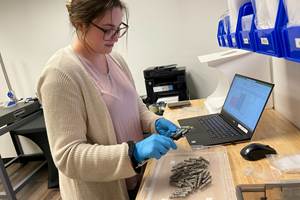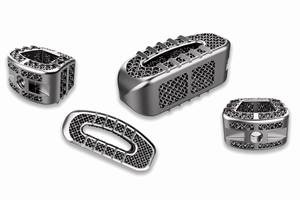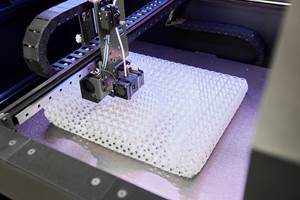Carbon-Fiber Reinforced PEEK filament for Long-Term 3D Printed Medical Implants
Evonik’s VestaKeep carbon-fiber reinforced PEEK filament offers a balance of high strength, ductility and low weight making it a suitable metal-free alternative for implants.
The VESTAKEEP iC4612 3DF and VESTAKEEP iC4620 3DF materials are the two available filaments featuring 12% and 20% carbon fiber content, respectively. Photo Credit: Evonik
Evonik has developed two variations of a carbon-fiber reinforced PEEK filament for use in 3D printed medical implants. This smart biomaterial can be processed in common extrusion-based 3D printing technologies such as fused filament fabrication (FFF) and fused deposition modeling (FDM).
The VestaKeep iC4612 3DF and VestaKeep iC4620 3DF materials are the two available filaments featuring 12% and 20% carbon fiber content, respectively. The two grades offer a choice of material depending on the required strength and flex properties of 3D printed implants such as bone plates and other reconstructive prostheses.
The two materials offer a variety benefits, including strength from the high carbon-fiber content, matched with the ductility of its PEEK component. Additional benefits include the ability to define the alignment of the carbon fibers during the 3D printing process, high biocompatibility for metal allergy-patients, and no X-rays artifacts.
“By introducing the world’s first carbon-fiber reinforced PEEK filament for long-term medical implants, we continue to design biomaterials that open up new possibilities in today’s medical technology for patient-specific treatment,” says Marc Knebel, head of Medical Systems at Evonik. “As passionate experts with decades of experience in polymer chemistry, we combine a unique set of competencies in materials science, manufacturing technologies and regulatory expertise to customers to accelerate time-to-market of new medical technologies for people's lives beyond limits.”
With a diameter of 1.75 mm, VestaKeep iC4612 3DF and VestaKeep iC4620 3DF are supplied on 500-g and 1,000-g spools that can be used directly in standard FFF/FDM 3D printers for PEEK materials. The filament is subjected to strict quality management for medical materials.
“No other application field showcases more the advantages of 3D printing, such as individualization or design freedom, than medical technology,” says Knebel. “In trauma applications, for instance, 3D printed solutions offer an enormous time advantage over traditionally manufactured medical devices. It is conceivable that patient-specific solutions can be manufactured within two or three days, significantly improving the recovery phase.”
Over the last five years, Evonik has been gradually developing new PEEK-based filaments for medical 3D printing applications. The current portfolio includes different grades for long-term and short-term body contact applications:
Long-term body contact applications:
- VestaKeep i4 3DF - Implant grade (long-term)
- VestaKeep i4 3DF-T - Test and development grade
- VestaKeep iC4800 3DF - Osteoconductive implant grade
- VestaKeep iC4612 3DF – Carbon-fiber reinforced (12%) implant grade
- VestaKeep iC4620 3DF – Carbon-fiber reinforced (20%) implant grade
Short-term body contact applications:
- VestaKeep Care M40 3DF - Medical care grade
- Learn more about Evonik’s material offerings with the addition of three INFINAM photopolymers to its product portfolio. These photoresin products are for use in common UV-curing 3D printing processes such as stereolithography (SLA) or Digital Light Processing (DLP).
- Read about Evonik’s collaboration with Farsoon on the INFINAM Thermoplastic Copolyester. INFINAM TPC (thermoplastic copolyester) is a ready-to-use, elastomer-grade material for powder bed fusion 3D printing that can enable customers to unlock new markets and applications.
Related Content
Production AM Demands Process and Procedures — More Machines Will Come Later
Arch Additive has transitioned to full production of implants made through electron beam melting. The transition has involved practices and personnel, not equipment. As customer products win approval and go to market, here are 5 operational moves the AM implant manufacturer has made.
Read MoreNMPA Certifies Farsoon 3D Printed Tantalum Interspinal Fusion Cage
The company says the additively manufactured implants can be fully customized according to patients’ conditions, and the trabecular microstructure can achieve a high porosity of 68-78% to promote bone tissue and vessel fusion.
Read MoreDMG MORI: Build Plate “Pucks” Cut Postprocessing Time by 80%
For spinal implants and other small 3D printed parts made through laser powder bed fusion, separate clampable units resting within the build plate provide for easy transfer to a CNC lathe.
Read MorePartners Improve Wheelchair Seats, Cushions Using 3D Printed Programmable Foam
The 3D printed programmable foam is said to enhance orthopedic seats and cushions, offering improved comfort and reliability for users.
Read MoreRead Next
Bike Manufacturer Uses Additive Manufacturing to Create Lighter, More Complex, Customized Parts
Titanium bike frame manufacturer Hanglun Technology mixes precision casting with 3D printing to create bikes that offer increased speed and reduced turbulence during long-distance rides, offering a smoother, faster and more efficient cycling experience.
Read MoreAlquist 3D Looks Toward a Carbon-Sequestering Future with 3D Printed Infrastructure
The Colorado startup aims to reduce the carbon footprint of new buildings, homes and city infrastructure with robotic 3D printing and a specialized geopolymer material.
Read MorePostprocessing Steps and Costs for Metal 3D Printing
When your metal part is done 3D printing, you just pull it out of the machine and start using it, right? Not exactly.
Read More





















